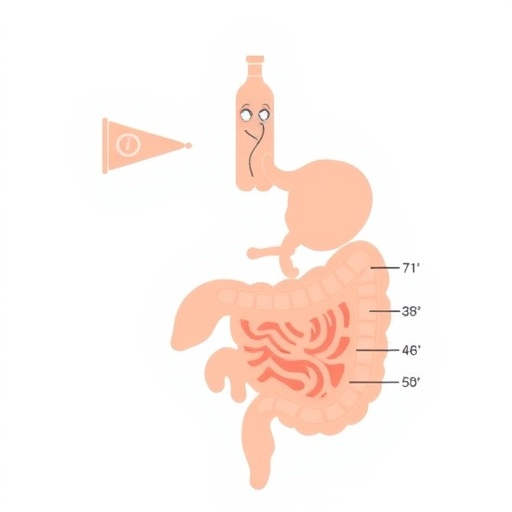In a groundbreaking retrospective nested case-control study published in the prestigious journal BMC Cancer, researchers have unveiled compelling evidence that links postoperative hypouricemia—a marked decline in serum uric acid (sUA) levels—to an increased risk of postoperative complications in patients undergoing surgery for gastrointestinal (GI) cancer. Spanning data from 708 patients treated at a tertiary hospital between 2018 and 2020, the study’s robust findings challenge existing postoperative monitoring paradigms and suggest a novel biomarker that could revolutionize the clinical management of surgical GI cancer patients.
The investigation ventured into an uncharted area focusing on sUA fluctuations during and after cancer surgery procedures. Serum uric acid, widely recognized as a byproduct of purine metabolism, traditionally garners attention for its role in gout and renal dysfunction. However, its potential role as an indicator of systemic physiological stress or immune responses in the postoperative period has remained elusive. This study boldly explores this frontier, aiming to decode whether hypouricemia can serve as a prognostic marker signaling the onset of surgical complications.
Methodologically, the researchers adopted a meticulous approach. From the patient cohort, 149 cases with recorded postoperative complications were matched with 149 controls without complications using propensity score matching based solely on age (within ±2 years) and sex. The matching aimed to neutralize confounding biases inherent in retrospective analyses. Serum uric acid levels were rigorously measured at three critical time points: preoperative baseline (D₀), within 24 hours post-surgery (D₁), and between postoperative days 1 to 4 (D₂). Crucially, hypouricemia was stringently defined per established sex-specific thresholds (below 208 µmol/L for males, and 155 µmol/L for females).
The statistical analysis employed included conditional logistic regression models to determine odds ratios (OR) associating hypouricemia with complications, supplemented by Receiver Operating Characteristic (ROC) curve analysis to evaluate the predictive accuracy of sUA measurements. Such techniques ensured that the findings were not mere correlations but suggested potential predictive clinical utility.
Results from this comprehensive examination were striking. The cohort’s overall postoperative complication rate was 21.05%, with severe complications constituting 15.54% of cases. At every time point measured, patients experiencing complications demonstrated significantly lower mean serum uric acid levels compared to controls (D₀: 319.68 vs. 343.59 μmol/L; D₁: 212.25 vs. 258.68 μmol/L; D₂: 137.66 vs. 188.73 μmol/L). These declines were not only statistically significant (p-values < 0.01) but exhibited a clear temporal trend intensifying in the immediate postoperative days.
Furthermore, the prevalence of hypouricemia among complicated cases was profoundly higher on D₁ (68 vs. 26 in controls) and D₂ (135 vs. 83), with chi-square tests confirming these differences were robustly significant (p < 0.001). Adjusted logistic regression models highlighted that hypouricemia on D₁ increased the odds of postoperative complications by 2.64 times, escalating dramatically to over 11 times on D₂. These findings suggest that the magnitude of postoperative serum uric acid decline may reflect or even predict the underlying pathophysiological processes precipitating complications.
To quantify the predictive power of sUA, the study conducted ROC curve analysis, revealing moderate yet statistically meaningful predictive accuracy. The area under the curve (AUC) values were 0.659 for the D₁ measurement and 0.699 for the D₂ measurement, both statistically significant (p < 0.001). While not perfect predictors, these values indicate serum uric acid has potential as part of a multi-marker strategy to enhance postoperative risk stratification.
The biological underpinnings of these observations may lie in the interplay between uric acid metabolism and oxidative stress, inflammation, and immune system modulation following surgical trauma. Uric acid is known to possess antioxidant properties, and its depletion after surgery might reflect excessive neutralization of reactive oxygen species or increased renal clearance secondary to surgical stress responses. This depletion may impair the body’s ability to mediate oxidative damage and tissue repair, thereby predisposing patients to complications.
Clinically, these findings herald the possibility of integrating serum uric acid monitoring into postoperative care protocols. Current postoperative surveillance primarily relies on clinical observation, inflammatory markers, and imaging, which can sometimes detect complications after their onset. Incorporating sUA measurements could provide an earlier biomarker signal, enabling preemptive interventions and tailoring postoperative management to high-risk individuals.
However, investigators strongly caution that despite the strong associations observed, further prospective, large-scale, and mechanistic studies are essential to validate these findings and unravel the causal pathways. The retrospective design and single-center data limit generalizability. Additionally, confounding factors such as variations in hydration status, renal function, medication use, and nutritional status were not exhaustively controlled, warranting deeper inquiry.
This study lays a foundational framework for future research that could explore therapeutic modulation of uric acid levels or antioxidant capacity as potential avenues to mitigate postoperative morbidity in gastrointestinal cancer patients. It also exemplifies the broader trend in surgical oncology toward precision medicine where biochemical markers refine risk assessment beyond conventional metrics.
In summary, the study decisively identifies postoperative hypouricemia as a strong correlate and potential predictor of surgical complications in GI cancer patients. Its implications extend to improving postoperative surveillance, guiding clinical decision-making, and possibly illuminating novel therapeutic targets. As surgical oncology continues to seek strategies to optimize patient outcomes, serum uric acid emerges as a promising biomarker warranting focused attention.
The impact of such research transcends GI cancer surgery, inviting exploration in other surgical domains where postoperative complications represent significant challenges. Understanding the diverse roles of metabolic biomarkers like uric acid could revolutionize how clinicians anticipate and mitigate adverse events across multiple surgical specialties.
To translate these insights into clinical practice, interdisciplinary collaborations among surgeons, oncologists, clinical biochemists, and researchers will be vital. Furthermore, establishing standardized protocols for sUA measurement and defining precise threshold values for clinical action must be prioritized.
Ultimately, this study’s revelations propel the scientific community toward a future where dynamic postoperative biochemical monitoring enhances patient safety, accelerates recovery, and reduces healthcare burdens associated with surgical complications. The work by Shi et al. underscores the untapped potential residing in known metabolic compounds, prompting a reevaluation of their significance in perioperative medicine.
Subject of Research: Postoperative hypouricemia as a predictive biomarker for surgical complications in gastrointestinal cancer patients.
Article Title: The correlation between postoperative hypouricemia and postoperative complications in patients with gastrointestinal cancer: a retrospective nested case-control study.
Article References:
Shi, K., Xu, Hj., Lin, Zl. et al. The correlation between postoperative hypouricemia and postoperative complications in patients with gastrointestinal cancer: a retrospective nested case-control study. BMC Cancer 25, 1466 (2025). https://doi.org/10.1186/s12885-025-14949-5
Image Credits: Scienmag.com
DOI: https://doi.org/10.1186/s12885-025-14949-5
Keywords: postoperative hypouricemia, serum uric acid, gastrointestinal cancer, surgical complications, biomarker, retrospective study, ROC curve, Clavien-Dindo classification, postoperative risk stratification
Tags: clinical management of surgical patientscomplications after gastrointestinal surgerygastrointestinal cancer complicationsimmune response in surgerynovel biomarkers in surgerypostoperative hypouricemiapostoperative monitoring in GI cancerprognostic markers for surgery complicationspurine metabolism and cancerretrospective case-control studyserum uric acid levelssurgical risk factors





